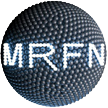The thermal evaporator is our "workhorse" general purpose thin film deposition system. It was originally manufactured by Denton, but it has been heavily modified over the years. It is a diffusion pumped bell jar chamber with three evaporator stations in the base plate. The chamber can reach pressures in the low 10-6 range after 1-2 hours of pumping. The chamber does not presently have a liquid nitrogen cold trap because its original trap developed a vacuum leak. A new or repaired cold trap would likely reduce the chamber's base pressure to the low 10-7 range.


